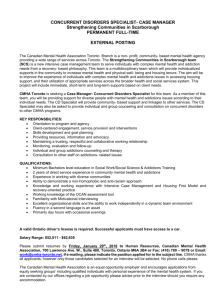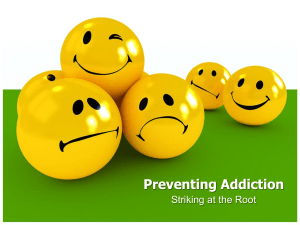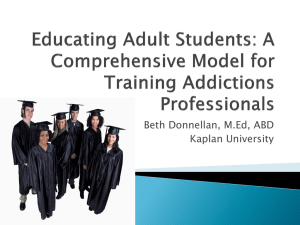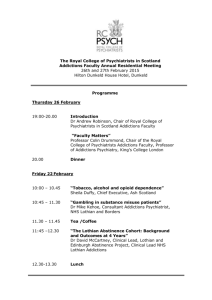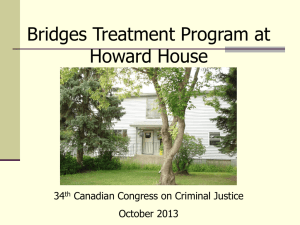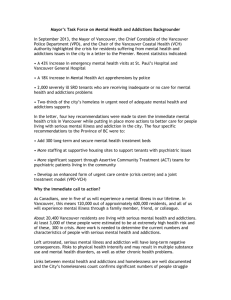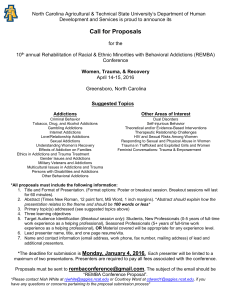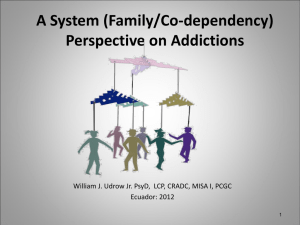Presentation by Dr. Vicky Stergiopoulos on the CATCH
advertisement
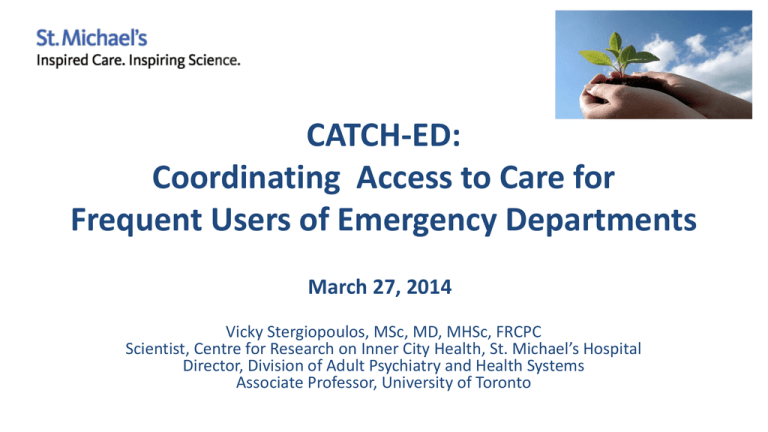
CATCH-ED: Coordinating Access to Care for Frequent Users of Emergency Departments March 27, 2014 Vicky Stergiopoulos, MSc, MD, MHSc, FRCPC Scientist, Centre for Research on Inner City Health, St. Michael’s Hospital Director, Division of Adult Psychiatry and Health Systems Associate Professor, University of Toronto Coordinating Access to Care for Frequent ED Users • People with mental illness and addictions are over-represented among frequent ED users • TC-LHIN Frequent Users Advisory Committee, 2012 o Review patterns of ED utilization o Identify approaches to decrease ED use and improve health outcomes • CATCH-ED was implemented in 2012, sponsored by the TC-LHIN and the MHA Acute Care Alliance o The program is an adaptation of a Critical Time Intervention Model, developed to support transitions of care for vulnerable populations The Target Population • People with mental health and addictions problems who make frequent use of TC-LHIN EDs o 2% (about 400 individuals) made 21+ visits in 2010/11 o Accounted for 20% of all ED visits by people visiting at least once for a MHA-related visit • Patient profile: o More likely to be male, middle-aged o Have depression and anxiety with or without substance use problems o Visit multiple EDs, non-emergent by CTAS score, not frequently admitted o Have variable primary care connections • Target population: people with 5+ visits in a single ED 3 CATCH-ED Partners and Roles Referral Sources CATCH-ED Case Managers Primary Care / Mental Health and Addictions Counseling Peer Outreach / Accompaniment Project Management and Coordination 6 Toronto Hospitals Emergency Departments 3 Community Mental Health Agencies 4 Community Health Centres 1 Community Support Service Agency Toronto Mental Health and Addictions Acute Care Alliance St. Michael’s Hospital St. Michael’s Hospital 4 When the Patient is the System…. Income support Employment/ education X DISCHARGE SERVICES Social integration Housing Hospital based care Legal support Crisis services Front line, specialized and intensive services Minister’s Advisory Group, Respect, Recovery, Resilience: Recommendations for Ontario’s Mental Health and Addictions Strategy http://www.health.gov.on.ca/en/public/publications/ministry_reports/mental_health/mentalhealth.aspx 5 Facilitating Transitions Building Continuity of Care • Grounded on inter-agency and inter-sectoral collaboration to address system fragmentation • Frequent users are given immediate access to primary care, mental health and addictions counseling and peer support • Program hypotheses: o Frequent users are not connected to primary care and mental health supports and services o Continuity of care will improve acute care utilization and health outcomes Transitional Case Management • TCMs work with participants for approximately 16 weeks focusing on addressing immediate needs and connecting to long term supports • Small case loads (1 TCM to 12-15 participants) • Intervention has 3 phases: o Engagement and Goal setting (Months 1-2) Frequent contact, crisis intervention, needs assessment, working alliance o Bridging and Connecting to Community Resources (Months 2-3) Referrals to community, practical needs assistance o Transitioning and Transfer of Care (Months 3-4) Less frequent contact, warm hand-off to long term supports, open door policy Program Evaluation • Implementation Evaluation o • Qualitative evaluation assessing barriers and facilitators to program implementation and service delivery 42 stakeholder interviews and one focus group Mixed Methods Outcome Evaluation o Randomized Controlled Trial measuring health service utilization, mental health and substance use, quality of life and service satisfaction 12 months after enrollment 167 participants randomized to CATCH-ED or usual care o Qualitative Evaluation to assess program’s key ingredients, areas for improvement and service satisfaction 13 key informant interviews, 20 participant interviews, focus group of service providers Implementation Evaluation • 42 in-depth stakeholder interviews and one focus group conducted to explore factors that helped or hindered program implementation: o 26 key informants o 6 service providers (primary care physicians and case managers) o 10 consumer participants • What has worked well with the program? • What are the areas for improvement? Implementation Evaluation: What has worked well? • Inter-sectoral, multi-agency partnerships and partner commitment o 4 TCMs and peer support drawn from existing resources o 4 CHC based counselors funded by the TC-LHIN • Opportunity to bridge the gap between hospitals and community agencies • Individualized service provision and low access barriers Implementation Evaluation: Challenges to Implementation • • • Multi-agency structure o Lack of clinical leadership o Inadequate training of frontline providers o Lack of central supervision / variable quality of supervision o Not integrated psychiatric care and counseling/therapy Referrals from Emergency Departments o Identifying frequent users (lists, automated flagging systems) o Referring frequent users (low program profile, “complex” referral process) Hand offs to long-term supports o Lack of high quality community-based MHA services and lengthy waitlists Implementation Evaluation: Changes made to the Program • Multi-agency structure o o o • Referrals from Emergency Departments o o o o • Additional TCM training on the CTI model Program manager to provide some central supervision and program cohesion Process measures to assess continuity of care and facilitate ongoing quality improvement Simplified referral process (single page, invitation script) Automated flagging system instituted at most hospitals “Champions” at each hospital, both at the frontline and administrative levels Routine presence of research team at hospital rounds Hand off to long term supports o Communication to the TC-LHIN Implementation Evaluation: Lessons Learned Hospital • • Ensure a standardized frequent user identification system is in place Need for dedicated ED staff to promote front-line buy in and facilitate the connection of frequent users to ongoing care Community • • • Simple referral process / low access barriers A centralized program structure and process measures to provide consistency/ quality in service delivery Case managers and counselors with the right skill mix and training Outcome Evaluation: Quantitative Component • 167 participants randomized to CATCH-ED or usual care and followed for 12 months. • The research questions are: o o Is a brief, case-management intervention effective in reducing ED visits for frequent ED users 12 months after program enrolment? Is the intervention effective in improving health outcomes for frequent ED users 12 months after program enrolment? • An economic evaluation will also be pursued to assess programs costs and cost effectiveness. • Data collection continues until October 2014 o Excellent follow up rates Qualitative Evaluation • 13 key informant interviews, focus group of service providers, 20 consumer participant interviews • The research questions are: o What are community stakeholder, frontline provider and consumer perspectives on the program? o What are the program’s key ingredients and theory of change? • Data collection completed • Data analysis underway Qualitative Evaluation: Emerging Findings The users • Frequent users have variable service connections, from “unconnected” to “highly connected” • Many frequent ED users have primary care support, but the majority are not connected to high quality multidisciplinary community mental health and addictions services • The emotional and social support provided by the Transitional Case Managers is viewed by participants as a key element of the program Qualitative Evaluation: Emerging Findings The service providers • Transitional case managers are called on to play a complex role with little training or supervision • Transitional case managers and participants have different views on service provider roles and service expectations highlighting the need for service standards and workforce development • The service period of 12-16 weeks may be too short to establish a strong working alliance and provide warm hand off to long term services Recommendations to Planners • Program monitoring and implementation evaluation have an important role to play in program improvement • Integrated care models that draw from multiple agencies require appropriate organizational structures • Service standards, training and technical assistance to frontline providers are needed to ensure high quality services • Frequent ED users with mental health and addictions problems have complex health needs requiring specialized multidisciplinary community based teams Acknowledgements Funders • • • • Toronto Mental Health and Addictions Acute Care Alliance BRIDGES Centre for Research on Inner City Health, St. Michael’s Hospital TC-LHIN Research Team • Co-Investigators: Zuhair Alsharafi, Tim Guimond, Stephen Hwang, Meldon Kahan, Paul Kurdyak, Molyn Leszcz, Pat O’Campo, Howard Ovens, Julie Spence, Peter Voore, Don Wasylenki • Research Staff: Deborah Wise Harris, Daniel Pauly and Caroline Patterson Your questions? Contact: Vicky Stergiopoulos Tel: 416-864-6060 x 6415 stergiopoulosv@smh.ca
